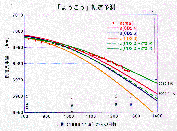
It was only a couple of weeks ago that we wrote a nugget that stirred up interest in the remaining life of the Yohkoh mission. We were asked the obvious question by a number of folks: Just how long is Yohkoh going to stay up? After a bit of thinking about this, we came up with a semi-believable model atmosphere and extrapolated the degradation of the spacecraft out to see when it would most likely re-enter. This amateurish attempt on the part of the SXT CO was enough to inspire the professionals to have another look at the current status quo.

It might be useful to click on the small graph above so you can read along as I read aloud to the class. This graph is compliments of Shuto_san, the expert at orbital predictions here at ISAS.
The x-axis is in days since November 5, 1996. The y-axis is the radius of the spacecraft orbit in kilometers. The little red diamonds are data points from the actual Yohkoh orbit, and the green line is seemingly an approximate fit to that line. If you follow that out to the right margin, you'll note that at this pace, assuming a solar maximum 80% that of the previous one, the spacecraft will re-enter in 2010.
The other lines are variations on this theme. The values labeled "CD2.4", "CD2.6" and "CD3.0" on the legend are variations in the orbital drag of the spacecraft. This is a hard number to calculate accurately, since the drag changes depending on the attitude of the instrument to the direction of travel. The last two items in the legend represent different values for solar activity; more activity implies less lifetime.
May 19, 2000